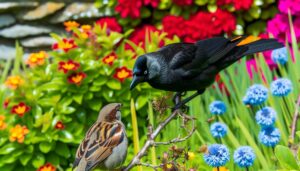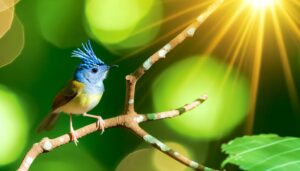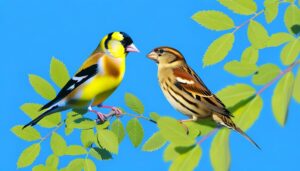7 Desert Predators That Will Eat the Black Sparrow
In the desert, black sparrows are preyed upon by various predators. Birds of prey like Red-tailed Hawks and owls utilize their keen vision and silent flight for effective hunting.
Terrestrial predators such as snakes target ground-nesting sparrows, while predatory lizards also pose significant threats. Nocturnal hunters like coyotes and certain owl species further endanger sparrows during nighttime.
Additionally, scavenging birds like vultures and ravens take advantage of any remains. Understanding these interactions reveals the intricate balance within the desert ecosystem, with every species playing a critical role in the survival dynamics of the black sparrow.
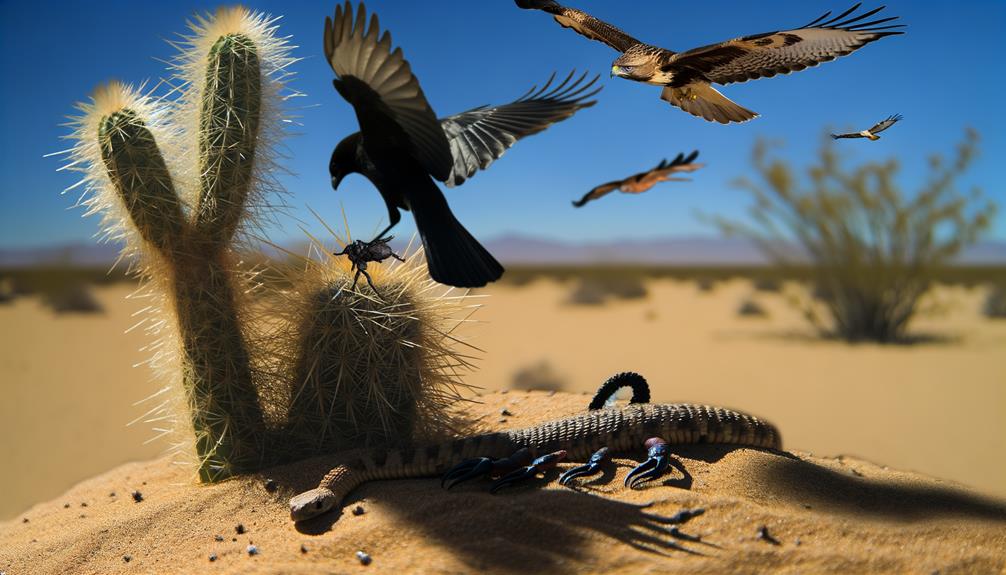
Key Takeaways
- Birds of prey like hawks and raptors hunt black sparrows.
- Nocturnal predators such as owls and coyotes target sparrows at night.
- Terrestrial predators like snakes prey on ground-nesting sparrows.
- Predatory lizards pose a threat to black sparrows.
- Scavengers like vultures and ravens consume sparrows when the opportunity arises.
Natural Predators
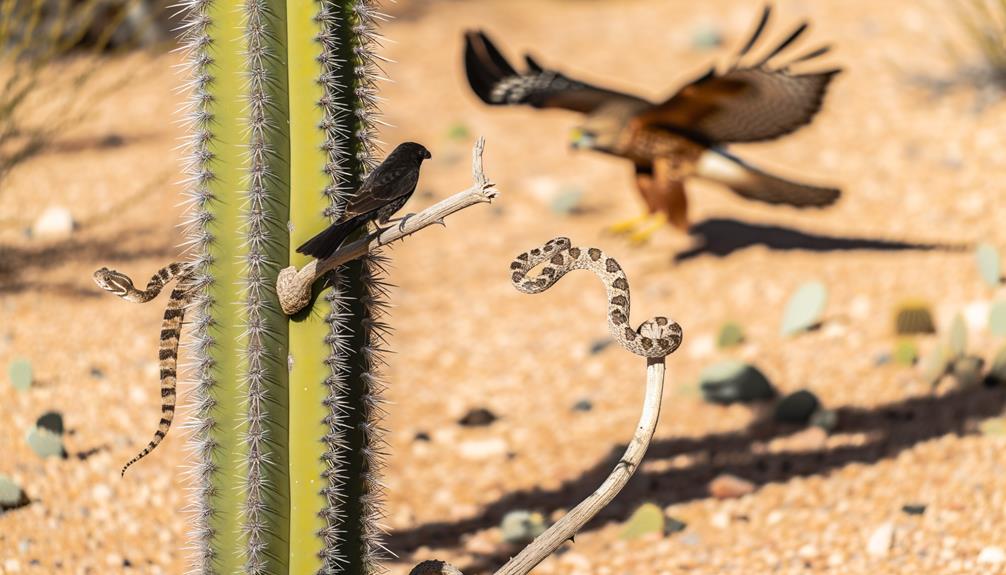
Natural predators of the black sparrow in the desert include birds of prey like hawks and owls, which frequently hunt these small birds for sustenance. These raptors utilize their acute vision and silent flight to locate and capture the sparrows. Observations reveal that hawks often employ soaring techniques, scanning the ground meticulously, while owls leverage their nocturnal advantage to ambush unsuspecting prey.
Additionally, the black sparrow faces threats from terrestrial predators such as snakes and small mammals, which exploit the bird's ground-nesting habits. Behavioral analysis indicates that black sparrows have developed evasive maneuvers, such as rapid, erratic flight patterns and strategic nesting in thorny shrubs, to mitigate predation risks.
Their survival demonstrates an intricate balance in the desert ecosystem.
Desert Birds of Prey
Desert birds of prey exhibit remarkable adaptations for survival in arid environments, such as specialized plumage for thermoregulation and acute vision for spotting prey.
Their hunting and feeding habits, including nocturnal activity and aerial hunting techniques, allow them to efficiently capture and consume small animals like the black sparrow.
Predation and competition dynamics among these raptors impact the local ecosystem, influencing prey populations and interspecies interactions.
Adaptations for Desert Survival
Birds of prey in arid environments showcase remarkable adjustments such as keen eyesight, silent flight, and specialized hunting techniques to efficiently locate and capture their prey. These avian predators possess extraordinary visual acuity, enabling them to spot small animals from great distances. Their feathers are designed for noise reduction, allowing them to approach prey stealthily. Morphologically adapted talons and beaks ensure efficient capture and consumption of prey. Behavioral adjustments include soaring at high altitudes to cover vast areas and utilizing thermal currents to conserve energy.
| Adjustment | Description |
|---|---|
| Keen Vision | Enhanced vision for detecting prey from afar |
| Noiseless Flight | Specialized feathers reducing noise during flight |
| Specialized Claws | Strong, curved talons for gripping and killing prey |
| Behavioral Techniques | Soaring and using thermals for energy conservation |
These adjustments are essential for survival in harsh desert ecosystems.
Hunting and Feeding Habits
Employing their remarkable adaptations, these desert birds of prey exhibit distinct hunting and feeding behaviors meticulously crafted to exploit their arid habitats. They capitalize on their sharp vision and powerful talons to secure prey in the sparse landscape.
Behavioral observations reveal:
- Aerial Surveillance: They utilize high-altitude gliding to spot potential prey from a distance, minimizing energy usage.
- Ambush Techniques: Some species, like the Harris's Hawk, often hunt in packs, using coordinated strategies to outsmart their targets.
- Thermal Soaring: By riding thermal updrafts, they conserve energy while scanning vast territories.
- Nocturnal Hunting: Owls leverage their exceptional night vision and silent flight to capture unsuspecting prey under the cover of darkness.
These tactics secure their survival in the challenging desert environment.
Predation and Competition Dynamics
In the harsh desert ecosystem, the interplay of predation and competition among avian predators creates a dynamic and ever-shifting balance of power.
Raptors such as the Red-tailed Hawk and the Peregrine Falcon exhibit territorial behavior, often engaging in aerial displays to assert dominance. These apex predators target smaller avian species, including the Black Sparrow, utilizing keen vision and swift strikes.
Competition for limited prey resources intensifies during drought periods, leading to shifts in hunting territories and feeding strategies. Observations reveal that interspecific competition isn't merely physical; it involves complex behavioral adaptations like altered flight patterns and vocalizations.
This intricate web of interactions underscores the adaptive resilience of these desert birds of prey, thriving despite extreme environmental pressures.
Reptilian Threats
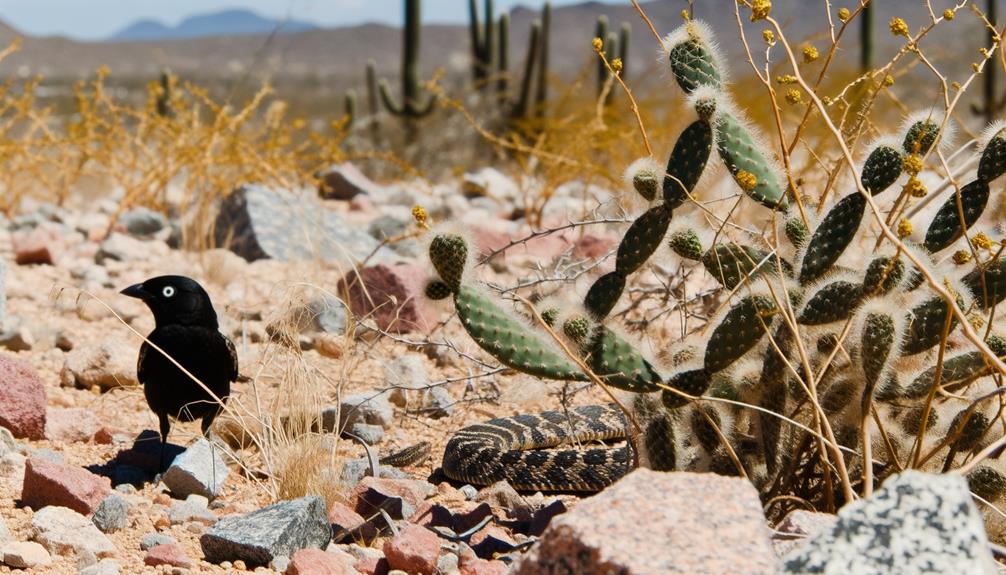
In the harsh desert environment, the Black Sparrow faces significant threats from a range of reptilian predators.
Opportunistic predatory lizards, such as the common collared lizard, actively prey on nestlings and eggs, exploiting moments when adult sparrows are away.
Additionally, venomous snakes like the sidewinder pose a lethal threat, utilizing their camouflaged approach and rapid strikes to capture unsuspecting birds.
Opportunistic Predatory Lizards
Equipped with keen senses and swift agility, predatory lizards such as the desert monitor and collared lizard pose a significant threat to the black sparrow. These reptiles employ various hunting techniques and exhibit remarkable adaptability to their arid surroundings. Their diet is opportunistic, often including small birds such as the black sparrow.
Key attributes of predatory lizards include:
- Enhanced Vision: Allows them to detect subtle movements of prey.
- Speed: Quick bursts of speed enable them to outmaneuver their targets.
- Camouflage: Their coloration helps them blend into the desert environment, making ambush tactics effective.
- Powerful Jaws: Capable of delivering a lethal bite to small avian prey.
Lacking the ability to escape swiftly, black sparrows often fall victim to these reptilian predators.
Venomous Snake Encounters
Venomous snakes, such as the sidewinder and the Mojave rattlesnake, present a formidable danger to the black sparrow through their stealth and potent venom. These serpents employ cryptic coloration and ambush tactics to capture their avian prey.
The sidewinder's unique lateral movement allows it to navigate sandy terrains efficiently, making it a silent threat. The Mojave rattlesnake's venom contains neurotoxins that swiftly incapacitate small birds, ensuring minimal escape opportunities. Observations show that black sparrows often fail to detect these camouflaged predators until it's too late.
Behavioral studies highlight the importance of the sparrow's vigilance and rapid flight response in evading such threats. However, even a momentary lapse can result in fatal encounters, underscoring the perilous existence of these desert dwellers.
Mammalian Hunters
Many mammalian predators, such as coyotes and bobcats, exhibit keen hunting strategies and adaptive behaviors that make the black sparrow a frequent target in arid desert ecosystems. These mammals possess acute senses and agile movements that facilitate their predatory success. The black sparrow's vulnerability is heightened by its ground-nesting habits and limited escape routes in the sparse vegetation.
- Coyotes: Utilize pack coordination and exceptional olfactory capabilities to locate nests.
- Bobcats: Employ stealth and powerful pounces to capture unsuspecting sparrows.
- Kit Foxes: Leverage their nocturnal activity patterns to hunt during the sparrow's resting periods.
- Badgers: Excavate ground nests with their robust claws, accessing hidden sparrow eggs and chicks.
These predators' diverse hunting techniques illustrate their adaptability and impact on black sparrow populations.
Insects and Arachnids
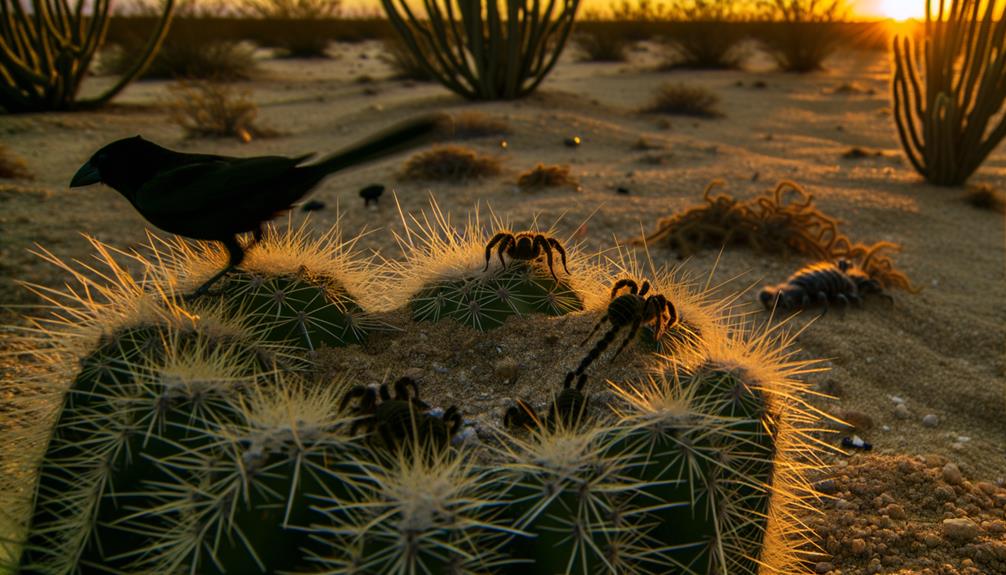
While mammalian predators pose a significant threat, various insects and arachnids also play an important role in the black sparrow's desert ecosystem.
Certain predatory insects, such as assassin bugs, exploit the vulnerability of fledgling sparrows. Their stealthy approach and potent venom make them formidable adversaries.
Meanwhile, arachnids like the desert tarantula and scorpions, specifically the Arizona bark scorpion, exhibit nocturnal hunting behaviors that can occasionally target young or injured sparrows. These arthropods utilize keen sensory adaptations to detect and capture prey efficiently.
The intricate dynamics between these invertebrate predators and the black sparrow underscore a complex web of interdependence and survival strategies, highlighting how even the smallest creatures can influence avian populations in arid environments.
Nocturnal Predators
Under the cover of darkness, nocturnal predators like owls and coyotes exploit their heightened senses and stealth to target black sparrows, whose reduced visibility leaves them vulnerable. Owls, with their acute night vision and silent flight, can pinpoint the exact location of an unsuspecting sparrow.
Coyotes, on the other hand, rely on their keen sense of smell and hearing to track down these small birds. The black sparrow's night-time behavior, such as roosting in low vegetation, makes it an easy target.
Key observations include:
- Owls' silent flight: Enables undetected approach.
- Coyotes' olfactory prowess: Locates hidden sparrows.
- Sparrows' roosting habits: Increase vulnerability.
- Night-time hunting efficiency: Maximized by predators' adaptations.
These behaviors underscore the predators' dominance in nocturnal ecosystems.
Opportunistic Scavengers
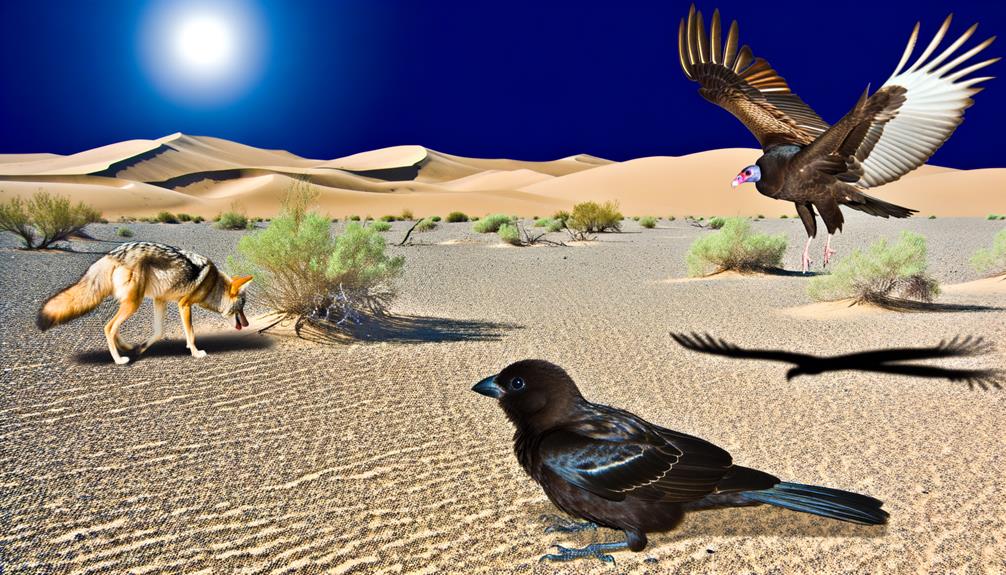
In addition to nocturnal predators, scavengers like vultures and ravens seize opportunities to feed on the remains of black sparrows left behind by other hunters. These scavengers exhibit exceptional foraging efficiency, utilizing sharp eyesight to locate carrion.
Vultures, with their robust digestive systems, can consume decomposing flesh that might be harmful to other animals. Ravens, known for their intelligence, often follow predators to take advantage of leftovers, displaying problem-solving behaviors to access food.
The interdependence between predators and scavengers ensures minimal wastage in the ecosystem. By scavenging, these birds play a vital role in nutrient recycling, contributing to the desert's ecological balance. Their adaptive behaviors illustrate the intricate dynamics of survival in arid environments, emphasizing resilience and resourcefulness.
Survival Strategies
Black sparrows employ a range of survival strategies, including cryptic coloration and agile flight patterns, to evade predators in the harsh desert environment. Their plumage blends seamlessly with the sandy terrain, rendering them nearly invisible to aerial hunters. Additionally, these birds exhibit remarkable agility in flight, capable of rapid, erratic maneuvers to outpace threats.
Here are four key survival strategies:
- Cryptic Coloration: Their feathers mimic the desert's hues, providing camouflage.
- Agile Flight Patterns: Quick, unpredictable movements help them evade predators.
- Nest Placement: They often nest in concealed locations, reducing detection risk.
- Vigilance: Constant alertness and communal alarm calls enhance group survival.
These behaviors collectively enhance the black sparrow's chances of surviving in a predator-rich environment.
Desert Food Web
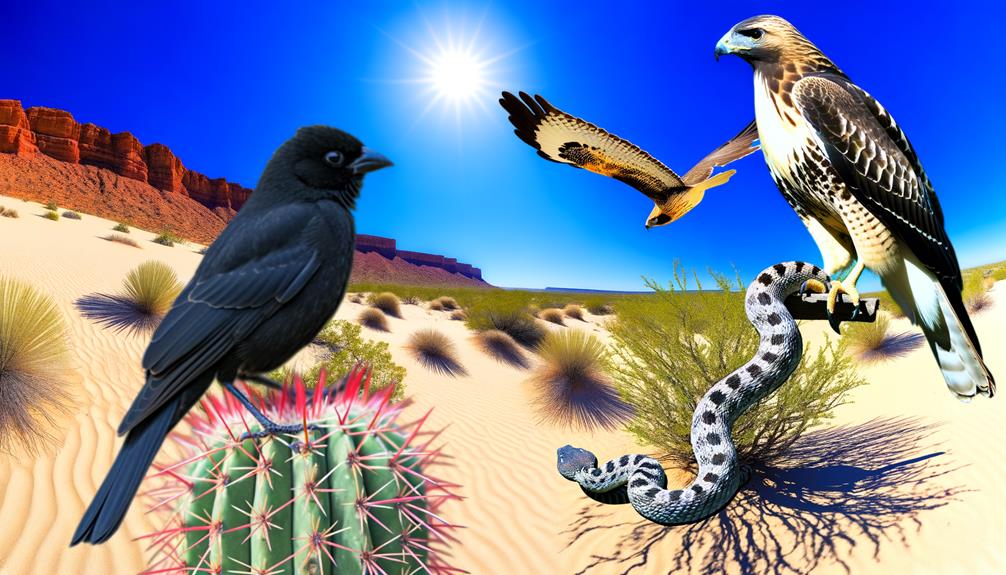
The desert food web intricately interconnects various species, with each organism playing a crucial role in maintaining ecological balance. Apex predators like coyotes and hawks regulate populations of smaller mammals and birds, making sure no single species dominates.
The black sparrow, an essential prey species, is consumed by snakes and predatory birds, which helps control insect populations. In turn, insects such as beetles and ants play decomposer roles, breaking down organic matter and recycling nutrients.
Plants like cacti and shrubs form the primary producers, capturing sunlight and converting it into energy for herbivores like rodents and insects. This interconnectedness guarantees a dynamic equilibrium, where each species' survival depends on both predation and resource availability, highlighting the desert's delicate yet resilient ecosystem.
Conclusion
In the harsh desert, poor black sparrows are everyone's favorite entrée. Birds of prey swoop in with the grace of a ballerina, while reptiles, not to be outdone, slither in for a crunchy snack.
Mammals, insects, and even arachnids join the buffet, proving that no one misses a meal in the desert. As nocturnal creatures plot under the moon and scavengers clean up the leftovers, one thing's clear: the desert's food web is a never-ending dinner party.

